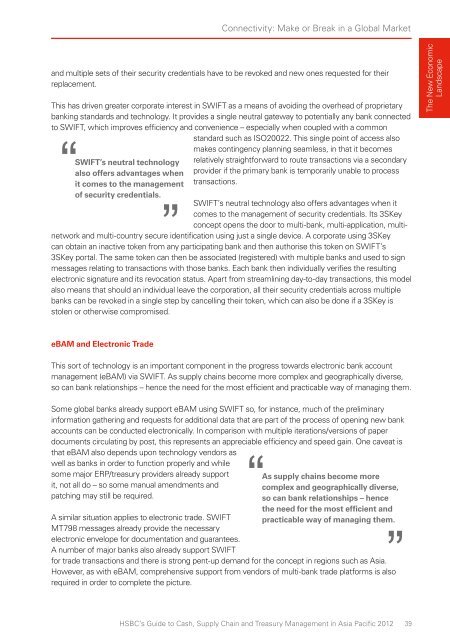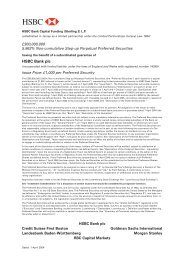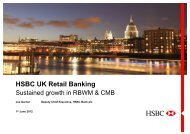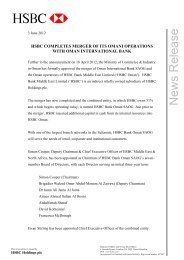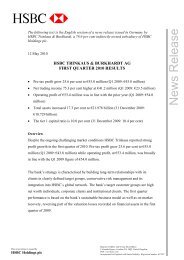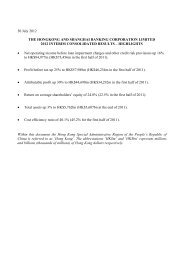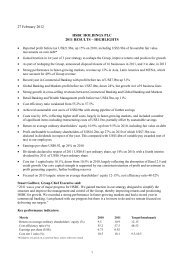HSBC's Guide to Cash, Supply Chain and Treasury Management in ...
HSBC's Guide to Cash, Supply Chain and Treasury Management in ...
HSBC's Guide to Cash, Supply Chain and Treasury Management in ...
Create successful ePaper yourself
Turn your PDF publications into a flip-book with our unique Google optimized e-Paper software.
Connectivity: Make or Break <strong>in</strong> a Global Market<br />
<strong>and</strong> multiple sets of their security credentials have <strong>to</strong> be revoked <strong>and</strong> new ones requested for their<br />
replacement.<br />
This has driven greater corporate <strong>in</strong>terest <strong>in</strong> SWIFT as a means of avoid<strong>in</strong>g the overhead of proprietary<br />
bank<strong>in</strong>g st<strong>and</strong>ards <strong>and</strong> technology. It provides a s<strong>in</strong>gle neutral gateway <strong>to</strong> potentially any bank connected<br />
<strong>to</strong> SWIFT, which improves efficiency <strong>and</strong> convenience – especially when coupled with a common<br />
st<strong>and</strong>ard such as ISO20022. This s<strong>in</strong>gle po<strong>in</strong>t of access also<br />
makes cont<strong>in</strong>gency plann<strong>in</strong>g seamless, <strong>in</strong> that it becomes<br />
SWIFT’s neutral technology<br />
also offers advantages when<br />
it comes <strong>to</strong> the management<br />
of security credentials.<br />
relatively straightforward <strong>to</strong> route transactions via a secondary<br />
provider if the primary bank is temporarily unable <strong>to</strong> process<br />
transactions.<br />
SWIFT’s neutral technology also offers advantages when it<br />
comes <strong>to</strong> the management of security credentials. Its 3SKey<br />
concept opens the door <strong>to</strong> multi-bank, multi-application, mult<strong>in</strong>etwork<br />
<strong>and</strong> multi-country secure identification us<strong>in</strong>g just a s<strong>in</strong>gle device. A corporate us<strong>in</strong>g 3SKey<br />
can obta<strong>in</strong> an <strong>in</strong>active <strong>to</strong>ken from any participat<strong>in</strong>g bank <strong>and</strong> then authorise this <strong>to</strong>ken on SWIFT’s<br />
3SKey portal. The same <strong>to</strong>ken can then be associated (registered) with multiple banks <strong>and</strong> used <strong>to</strong> sign<br />
messages relat<strong>in</strong>g <strong>to</strong> transactions with those banks. Each bank then <strong>in</strong>dividually verifies the result<strong>in</strong>g<br />
electronic signature <strong>and</strong> its revocation status. Apart from streaml<strong>in</strong><strong>in</strong>g day-<strong>to</strong>-day transactions, this model<br />
also means that should an <strong>in</strong>dividual leave the corporation, all their security credentials across multiple<br />
banks can be revoked <strong>in</strong> a s<strong>in</strong>gle step by cancell<strong>in</strong>g their <strong>to</strong>ken, which can also be done if a 3SKey is<br />
s<strong>to</strong>len or otherwise compromised.<br />
eBAM <strong>and</strong> Electronic Trade<br />
This sort of technology is an important component <strong>in</strong> the progress <strong>to</strong>wards electronic bank account<br />
management (eBAM) via SWIFT. As supply cha<strong>in</strong>s become more complex <strong>and</strong> geographically diverse,<br />
so can bank relationships – hence the need for the most efficient <strong>and</strong> practicable way of manag<strong>in</strong>g them.<br />
Some global banks already support eBAM us<strong>in</strong>g SWIFT so, for <strong>in</strong>stance, much of the prelim<strong>in</strong>ary<br />
<strong>in</strong>formation gather<strong>in</strong>g <strong>and</strong> requests for additional data that are part of the process of open<strong>in</strong>g new bank<br />
accounts can be conducted electronically. In comparison with multiple iterations/versions of paper<br />
documents circulat<strong>in</strong>g by post, this represents an appreciable efficiency <strong>and</strong> speed ga<strong>in</strong>. One caveat is<br />
that eBAM also depends upon technology vendors as<br />
well as banks <strong>in</strong> order <strong>to</strong> function properly <strong>and</strong> while<br />
some major ERP/treasury providers already support<br />
it, not all do – so some manual amendments <strong>and</strong><br />
patch<strong>in</strong>g may still be required.<br />
As supply cha<strong>in</strong>s become more<br />
complex <strong>and</strong> geographically diverse,<br />
so can bank relationships – hence<br />
the need for the most efficient <strong>and</strong><br />
practicable way of manag<strong>in</strong>g them.<br />
A similar situation applies <strong>to</strong> electronic trade. SWIFT<br />
MT798 messages already provide the necessary<br />
electronic envelope for documentation <strong>and</strong> guarantees.<br />
A number of major banks also already support SWIFT<br />
for trade transactions <strong>and</strong> there is strong pent-up dem<strong>and</strong> for the concept <strong>in</strong> regions such as Asia.<br />
However, as with eBAM, comprehensive support from vendors of multi-bank trade platforms is also<br />
required <strong>in</strong> order <strong>to</strong> complete the picture.<br />
HSBC’s <strong>Guide</strong> <strong>to</strong> <strong>Cash</strong>, <strong>Supply</strong> <strong>Cha<strong>in</strong></strong> <strong>and</strong> <strong>Treasury</strong> <strong>Management</strong> <strong>in</strong> Asia Pacific 2012 39<br />
The New Economic<br />
L<strong>and</strong>scape


